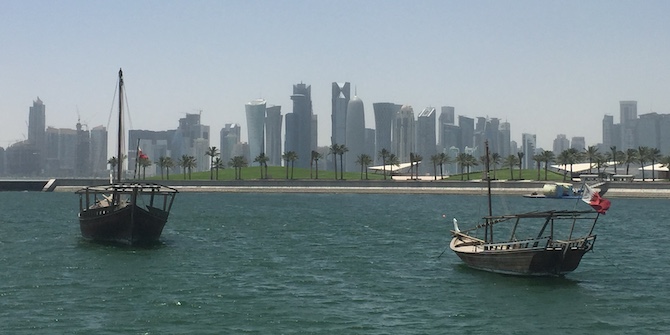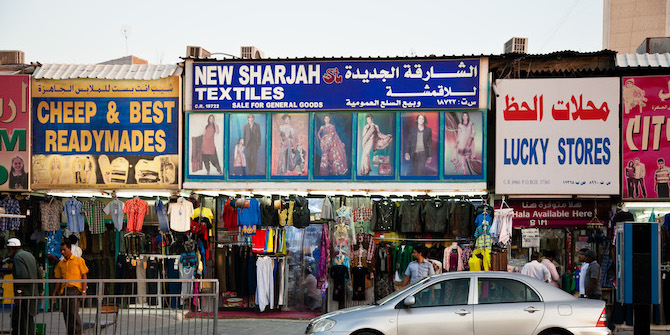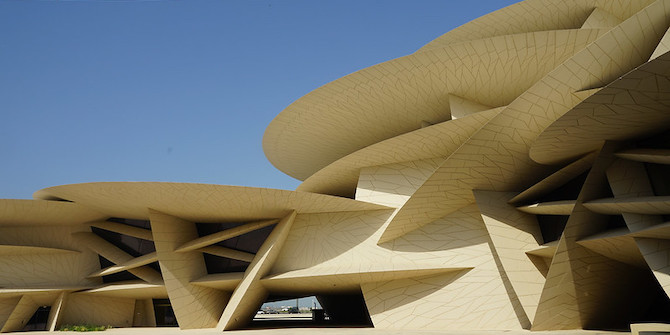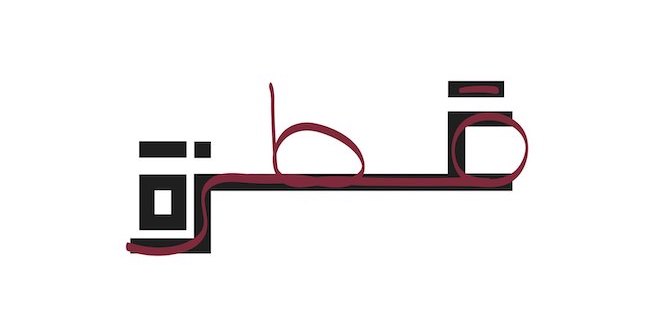by Alainna Liloia

In Qatar’s crowded capital city, a walk along the Doha corniche provides locals and tourists alike with an iconic view of the city’s impressive skyline and wooden dhows (boats) floating along the shore of the Doha Bay. While the towering skyscrapers are an invention of modern architecture, the dhows reference the nation’s pre-oil era during which they functioned as important trading vessels for fishermen and pearl divers. After taking in the view, one needs only to cross the highway via an underground and air-conditioned tunnel to reach the famous Souq Waqif, a ‘traditional’ market containing a number of restaurants and shisha lounges and a variety of shops selling clothes, souvenirs, and other merchandise.
The downtown scene is a great example of how the modern and traditional coexist and often merge in the small, oil-rich nation. As rapid development and modernisation have led to major changes in the nation’s cultural and social fabric, the Qatari state has continued to pride itself on the preservation of culture and tradition. This is evident in its development of a cultural heritage industry – consisting of cultural institutions like museums, traditional markets, renovated buildings and even cultural festivals.
The state’s efforts to preserve culture are intended to distinguish the nation from other Middle Eastern states and attract tourism. But they also aim to arouse a sense of national identity and belonging among the Qatari population.
A Minority National Population and Westernisation
The state of Qatar’s current political agendas focus heavily on balancing modernisation with the preservation of tradition. This is in response to the concerns of Qatari citizens that modern development is causing the nation to become too Westernised and lose sight of its heritage.
Fears that Qatar is losing its cultural identity are arguably well-founded in a country where the national Qatari population is a minority of about 11 percent. After the discovery of natural gas in the 1970s, increased oil wealth and development led to influxes of foreign workers in the nation as well as Western business professionals looking to profit from the nation’s newfound wealth. Western college campuses can even be found in Qatar’s Education City, which opened in 2003.
Yet, the rhetoric found in Qatari state documents insists that the nation will preserve its cultural identity. Qatar’s National Vision 2030, which was issued in 2008 and outlines the state’s development goals, states ‘Despite rapid economic and social gains, as well as political change, Qatar has maintained its cultural and traditional values as an Arab and Islamic nation.’ The document even mentions the need for institutions that ‘preserve Qatar’s national heritage and enhance Arab and Islamic values and identity.’ Similarly, Qatar’s National Development Strategy issued in 2011 mentions the importance of preserving the nation’s traditions, stating ‘The primary, persistent challenge is to maintain this balance between modern life and the country’s cultural and traditional values.’
Creating cultural institutions, museums and festivals is one way that the state of Qatar has attempted to fulfil its promises of preserving tradition. Even if the national population is a minority, heritage initiatives aspire to give Qataris the sense that they still belong in the nation and that the nation still belongs to them.
The Development of Cultural Heritage Projects
The development of cultural heritage projects in Qatar and the rest of the Arab Gulf nations can be traced back to the 1970s. This was when national boundaries were drawn through the tribal territories of the region to create distinct Arab states. State rulers needed to gain the loyalty of their national populations in order to maintain stability and rule, so they looked for ways to promote a sense of national identity that would take precedence over tribal identities and allegiances.
Qatar’s first national museum was founded in 1975, but in recent years, Qatar has focused even more on promoting a strong cultural identity through heritage projects. Qatar’s National Museums Authority (now Qatar Museums) was founded in 2005 and its revitalisation projects have included restoring ‘heritage buildings’ like pearl merchants’ houses to showcase local architecture from the nineteenth and twentieth centuries. It has also founded numerous museums like the Museum of Islamic Art (MIA), The Arab Museum of Modern Art (Mathaf) and the National Museum of Qatar.
Other recent examples of Qatari heritage projects include the restoration of the traditional market Souq Waqif in 2004, the founding of another traditional market Souq Al-Wakrah in 2008, the emergence of cultural festivals like the Traditional Dhow Festival since 2011, and the celebration of National Day since 2007. Souq Waqif is home to one of the few traditional Qatari restaurants in the nation, and some Qataris claim that the market was built on the foundations of an ancient town.
These projects certainly attract tourism and international attention. But they can also provide Qataris with assurance that the nation has not lost its traditions or culture and the feeling that a distinct Qatari identity still exists. On the Qatar Museums (QM) website, the QM’s chairperson Sheikha Al Mayassa is quoted as saying, ‘We are changing our culture from within, but at the same time we are reconnecting with our traditions.’ Her emphasis on the importance of tradition echoes the state’s rhetoric. She acknowledges the inevitability of change but holds that traditions can remain intact in spite of it.
The QM website also states, ‘We preserve the parts of the country that unite residents with Qatar’s past so that local audiences can retain their connection to years gone by, even as the immediate environment around us transforms.’ Cultural heritage projects can offer Qataris with tangible (and perhaps idealised) representations of their nation’s past and a sense of distinct culture and identity in the present. Latifa Al-Muftah, a wealthy middle-aged Qatari woman, expressed this sentiment succinctly, ‘Keeping our morals and values is important. For a while, we lost our tradition… Now we are returning to it.’






Qatar National Day is a national commemoration of Qatar’s unification in 1878. It is celebrated annually on 18 December. The holiday was established by a 21 June 2007 decree of the then Crown Prince and Heir Apparent Sheikh Tamim bin Hamad Al Thani. It is also known as Founder’s Day.